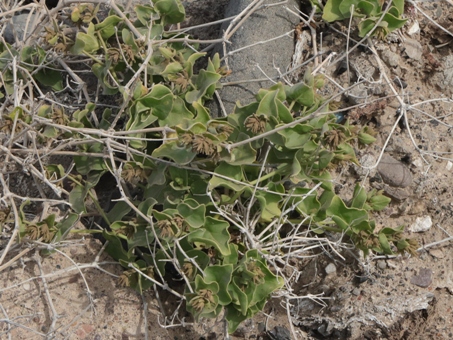This section contains entries about our botanizing in Baja California written for the UC BEE (Oct 2012 to Aug 2021)
and The UC Hive (2022-), monthly newsletters for volunteers and staff of the UC Berkeley Botanical Garden.
Click on any photo for a larger image.
THE UC HIVE MAY–JUNE 2022
El Desierto de Vizcaíno
This is Part 2 of our Vizcaíno Desert trip in February that began in my April 2022 entry (don´t miss the whale watching!). You´ll find a few more plants from around the towns of Guerrero Negro, Vizcaíno and Laguna Ojo de Liebre, as well as some from along the way to Mulegé and the Gulf.
Additional posts from the Vizcaíno Desert region can be found in my UC Bee blogs from June 2013, June 2014, July 2015, Dec 2018, Feb 2019, Mar 2020, Apr 2020 and Aug 2020
Near the 28th Parallel (BC - BCS border)
As I described last month, this area consists of a silty-sandy substrate with pockets of very low sand dunes. It is located a few miles from the Pacific coast and is subject to strong winds both from the coast and from the north. Dominant shrubby plants are Frankenia palmeri (Frankeniaceae), Lycium spp. (Solanaceae), Atriplex julacea, A. linearis and Suaeda nigra (Chenopodiaceae). Foliose and fruitcose lichens are quite common as epiphytes on these shrubs. A few low cactus species also occur sporadically, mainly Lophocereus schottii and Cylindropuntia spp. (Cactaceae).
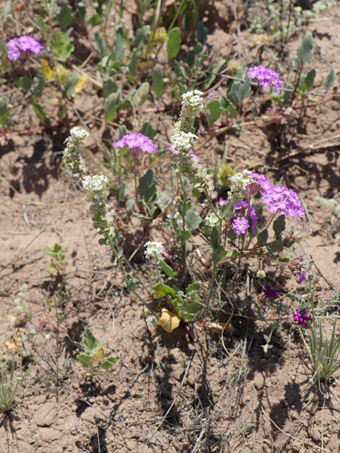
Mixture of tiny plants, with California Spectacle-pod (Dithyrea californica) and Slender Sand Verbena (Abronia gracilis) dominating here.
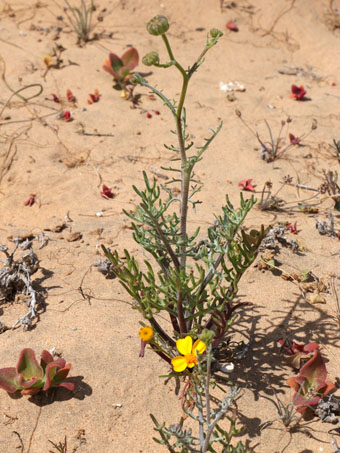
Peninsular Dyssodia (Boeberastrum anthemidifolium, yellow, Asteraceae) with larger Vizcaíno Pincushion (Chaenactis lacera, Asteraceae) in bud, behind.
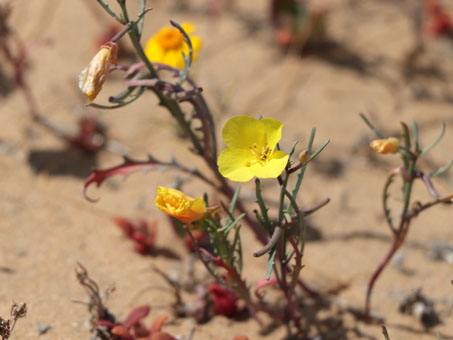
Baja California Suncup (Eulobus angelorum, Onagraceae) is endemic to the peninsula and is generally erect (5-90 cm H), with dissected cauline leaves and a globose stigma.

Vizcaíno Suncup (Eulobus angelorum, Onagraceae). Note the globose stigmas (seen best as shadows on the petals).
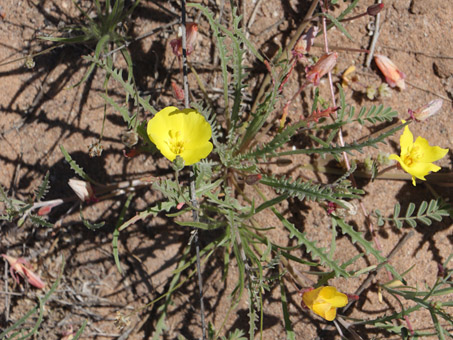
Vizcaíno Suncup (Eulobus sceptrostigma, Onagraceae) is also endemic to the peninsula. It grows generally in a rosette (to about 20 cm H in large plants) with pinnatifid leaves and a club-shaped stigma.
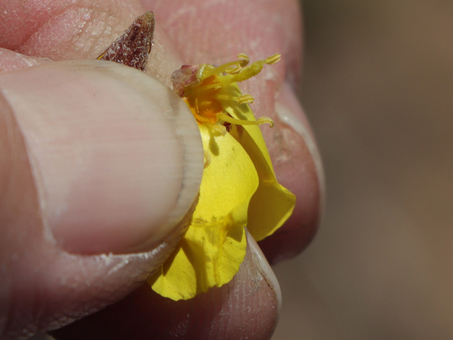
Vizcaíno Suncup (Eulobus sceptrostigma). Note the elongated stigma near the top of the flower, flanked by two stamens, one seeming to stick out of its tip.
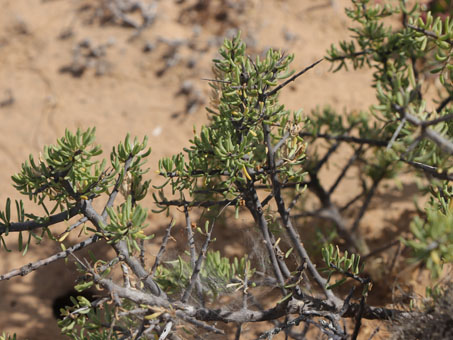
There are at least two Desert Thorn species nearby. This is Lycium californicum (Solanaceae), with needle-like leaves that are terete to slightly flattened. Flowers, when present, are white.
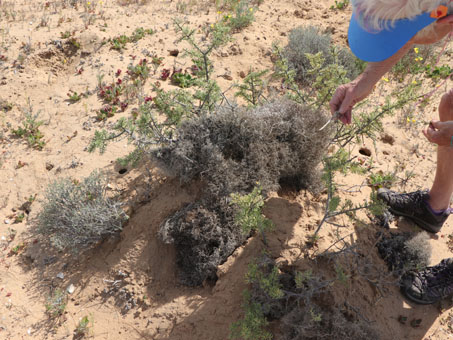
The same Lycium californicum plant, with a dense covering of fog lichen species (Niebla spp.)

A closeup of the leaf surface of Crystalline Iceplant (Mesembryanthemum crystallinum, Aizoaceae) showing the salt-sequestering vesicles.
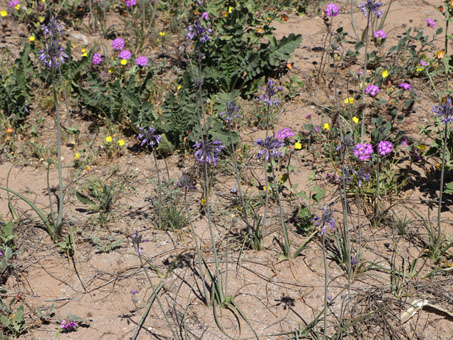
It was turning out to be another great year for Palmer Sand-lily (Triteleiopsis palmeri, Themidaceae). While most were shorter than we'd seen a few years ago, there were thousands everywhere we looked.
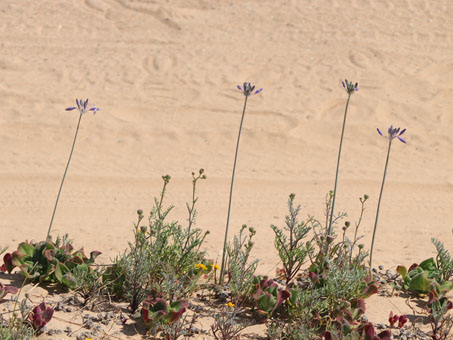
Here, the scapes of Palmer Sand-lily rises well above the new plants of Vizcaíno Pincushion and Crystalline Iceplant.
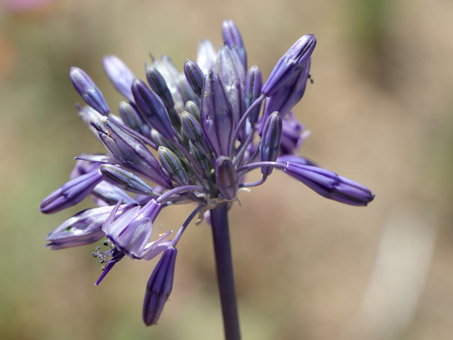
Palmer Sand-lily flowers up close and just starting to open.
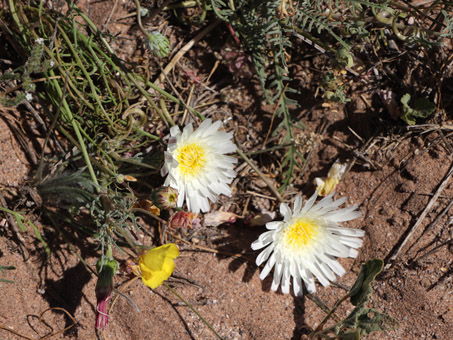
Desert Dandelion (Malacothrix glabrata, Asteraceae) is a native more common in the northern part of the peninsula, but it ranges only as far south as San Ignacio in BCS. It's quite common in the areas we visited.
Km 103 N of San Ignacio — Volcán Tres Vírgenes Area
This area is well out of the sandy substrate of the Vizcaíno Desert and I would describe it as a transitional region, or ecotone, between the Vizcaíno and the Central Gulf Coast region. Here the highway passes through dense desert scrub and there´s a nice turnout nearby, perfect for a lunch break and brief plant foray.
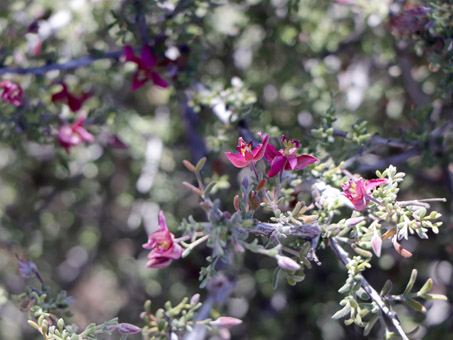
The Little-leaf Rhatany (Krameria erecta, Krameriaceae) were in full bloom. I love the delicate, fruity smell of the intricate flowers that are especially attractive to oil bees. Flowers are about 10-12 mm D.
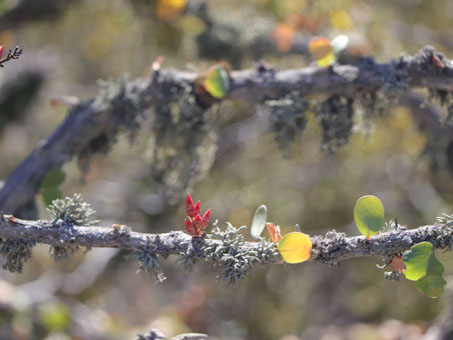
A common sight in this area: the branches of many shrubs, here Palo Adán (Fouquieria diguetii, Fouquieriaceae) are bedecked by clumps of lichens. The red is a cluster of Palo Adán flower buds.
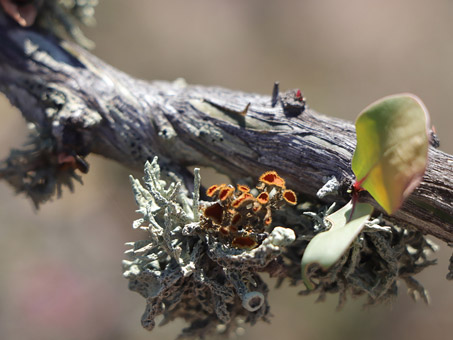
At least two lichens are represented here. The "eyelashes" on the orange cups (Golden-eye Lichen, Teloschistes chrysophthalmus) are cool.
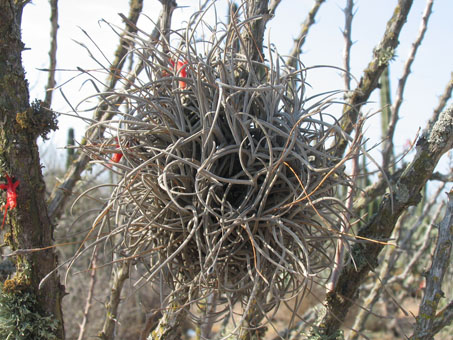
Some of the Palo Adáns sported curly clumps of Ball Moss (Tillandsia recurvata), an epiphyte in the Bromeliad family. They are usually well anchored around the spines of cactus or thornes/branches of other plants. This mass is about 15 cm D.
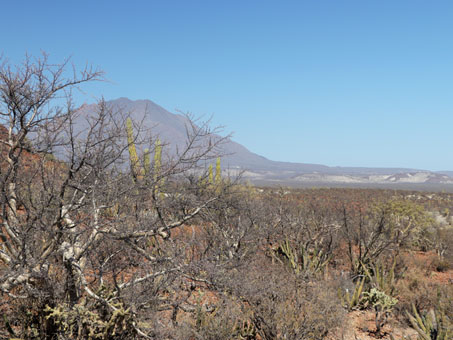
Closer to Volcán Tres Vírgenes the scrub was dry but the Arizona Lupines (Lupinus arizonicus, Fabaceae) were happily blooming, fruiting and going to seed along the highway for miles and miles.
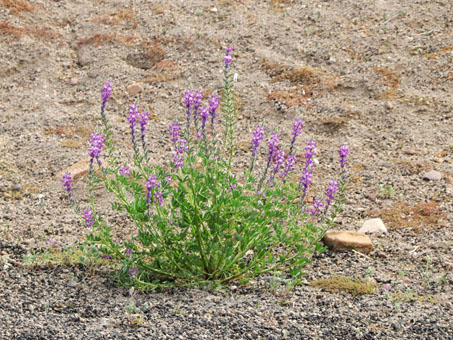
This Arizona Lupine plant is about 50-60 cm H.

Some flowers were deeper purple, or like these, more fuchsia.

Then there were the hairy pods and the tiny, speckled pebble-like seeds.
Santa Rosalía — North Beach Area
In one of those rare occurrences, I was pleasantly surprised to come across a new-to-me plant in the least likely of situations. While on our way north to Guerrero Negro, we had pulled onto a beach overlook at the side of the highway to eat our juicy roast chicken we´d just picked up in Santa Rosalía. While munching, my eyes wandered out over the calm sea and eventually came to rest on the rocky beach berm just below us. I was automatically and somewhat unconsciously surveying the plants along the beach and it took a few minutes to realize that a bunch of green mounds among the rocks had set off a quiet alert: "unknown shape!"
Promising my partner that I´d really just be a few minutes (we were already behind schedule but food had been essential, as for me were plants), I carefully made my way down to the berm and reached the shrubs. They were totally new, yet up close there was something familiar. I was sure I knew what genus I was looking at when I saw the calyx and fruit.
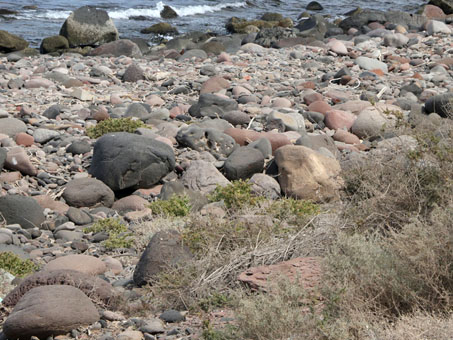
These were Longlobe Four O'Clock (Mirabilis tenuiloba, Nyctaginaceae).
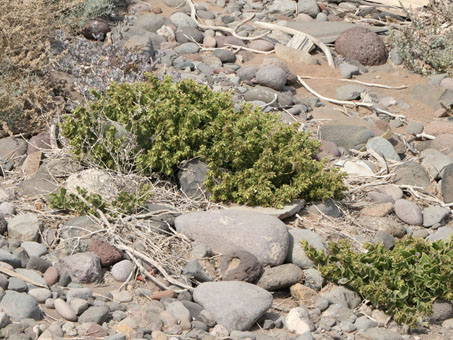
This native perennial is uncommon along the Gulf Coast from n BC to south of Loreto, BCS. It's also found across the Gulf and in California.
The bushy plants had thick, close-packed, fleshy leaves on spreading or ascending branches. They were mostly under 50 cm H x 60-70 cm W.
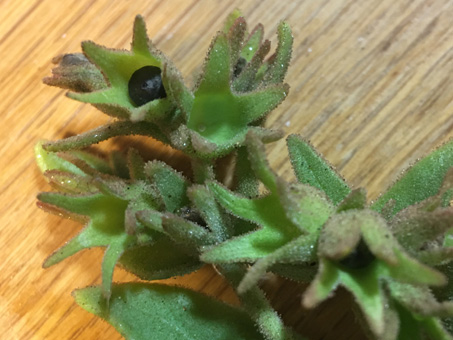
While there were no flowers present (showy & white), there were quite a few black, ovoid-globose fruit, each about 6 mm D. All the green plant parts were tacky, with stubby or stalked glandular hairs.
We've come to the end of this month´s wanderings. Next month, we'll all take a trip to the sierras where there will be some cave art to explore as well as a few plants. Until then, hasta luego...
Debra Valov—Curatorial Volunteer
References and Resources
Rebman, J. P., J. Gibson, and K. Rich, 2016. Annotated checklist of the vascular plants of Baja California, Mexico. Proceedings of the San Diego Society of Natural History, No. 45, 15 November 2016. San Diego Natural History Museum, San Diego, CA. Full text available online.
Rebman, J. P and Roberts, N. C. (2012). Baja California Plant Field Guide. San Diego, CA: Sunbelt Publications. Descriptions and distribution.
Valov, D. (2020). An Annotated Checklist of the Vascular Plants of Mulegé, Baja California, Mexico. Madroño 67(3), 115-160, (23 December 2020). https://doi.org/10.3120/0024-9637-67.3.115
Wiggins, I. L. (1980). The Flora of Baja California. Stanford University Press. Keys and descriptions.

























